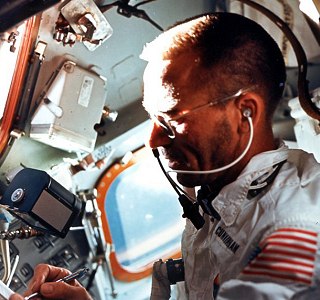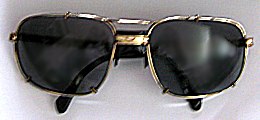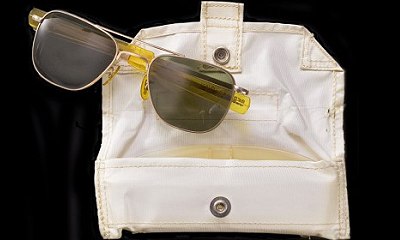Flown sunglasses |
||||||||||||||||||||||||||||||||||||||||||||||||||||||||||||||||||||
|
Although the windows on the Apollo Command Modules and Lunar Modules were small, the sunlight coming through them was not filtered by the Earth's atmosphere and so could be blindingly bright. In order to be able to work in this environment the astronauts were issued with sunglasses. |
||||||||||||||||||||||||||||||||||||||||||||||||||||||||||||||||||||
Apollo-era sunglasses
Walt Cunningham wearing A.O. sunglasses on Apollo 7 Prior to flying on Apollo 7, astronaut Walter Cunningham worked with an Australian opthalmologist to develop lightweight and durable sunglasses for the Apollo astronauts. 
Prototype Apollo sunglasses from Walter Cunningham's personal collection The project got as far as the prototype stage, with a unique pair of aluminum-framed sunglasses produced as shown on the right. In the end, however, the lengthy process required to get the design flight-qualified by NASA proved too much and an existing design already used by the Gemini astronauts was chosen instead. The sunglasses selected by NASA for use by the astronauts were American Optical Co. Original Pilot Sunglasses®, a model with a long history of use in the U.S. military.

The sunglasses & pouch carried by Mike Collins on Apollo 11 The Apollo stowage lists show that each astronaut carried a pair of sunglasses in a reinforced beta cloth pouch in a pocket of their in-flight garment, with the sunglasses of the Commander and Lunar Module Pilot traveling with them to the lunar surface and back.
Sunglass entries from the Apollo 10-17 Stowage Lists In addition, the stowage lists show three more pairs of sunglasses stowed in the survival kit that remained onboard the Command Module throughout the flight. In reality these were sun goggles, as can be seen in these images of the Apollo 11 survival kit at the NASM. The Smithsonian collection also contains a pair of sunglasses from Jim Mcdivitt's Gemini 4 survival kit. These appear to be a slightly modified pair of American Optical sunglasses (not the Original Pilot model) with some gauze added around the sides and nose area as protection against the sun, as can be seen here. None of the survival kit sun goggles or sunglasses were kept by the astronauts after their flights, but the Apollo astronauts were allowed to keep their personal pairs of A.O. sunglasses after the flights as momentos. In total, twenty seven pairs of these sunglasses were flown to the moon on board the Apollo lunar missions as part of the personal equipment of the astronauts. Twelve of those pairs were carried to the lunar surface in the lunar modules. Reading the Apollo technical debriefings it seems that many crews chose not to actually wear their sunglasses as they were found unnecessary. Some complained that if they wore them to make observations through the windows they needed to take them off again as soon as they tried to look at anything inside the spacecraft e.g. to make notations, making it easier just to leave them off all the time. By contrast, it's worth noting that the Apollo 16 crew described their sunglasses as mandatory. The Apollo 1 stowage lists show sunglasses with the same part numbers as used on the other Apollo flights. The sunglasses pouches have the same part number as the later versions but ending -201 rather than -203. This is consistent with the original pouches having been made from nylon then being produced in beta cloth (as version -203) following the fire. Note that two pairs of sunglasses sold by Buzz Aldrin at Superior auctions in Spring 1995 (lot 243) and Fall 1996 (lot 186), both listed as having been flown on Gemini 12, raise some interesting questions. Both pairs have Apollo-style part numbers, the 1995 example with S/N 02 and the 1996 example with S/N 43. The first pair was also accompanied by a beta cloth pouch, with part number SEB12100034-203 and with serial number 1040. The 02 serial number of the 1995-sold sunglasses marks them as one of the earliest Apollo-issue pairs. As the tail-end of the Gemini program did overlap with the beginning of the Apollo program perhaps it is possible that these sunglasses with Apollo-style part numbers were carried by Aldrin on Gemini 12. The beta cloth pouch that accompanied them, on the other hand, was definitely not flown on Gemini 12. Given the -203 part number and 1040 serial number I would strongly suspect that this was the sunglasses pouch carried by Aldrin on the Apollo 11 mission. That brings us to the sunglasses sold in 1996. Here again, the 43 serial number would strongly suggest that they were issued to Aldrin in 1969 so I believe these are probably the pair he carried on Apollo 11. I have entered these items in the Annex below assigned to the flights I suggest here rather than those of the original auction listings. FLOWN availability - The Apollo astronauts were allowed to keep their sunglasses after the mission and some of these have since been sold at auction. Most have been offered with the matching beta cloth pouch but some pouches have been sold separately, presumably because the sunglasses themselves were lost or damaged. Pairs of sunglasses have fetched anywhere between $3,520 (McDivitt's Apollo 9 pair) and $20,315 (Cernan's surface-flown Apollo 17 pair) at auction. See footnotes for more price examples. Unflown availability - NASA-issue sunglasses used in training are likely to exist but may be as difficult to track down as flown examples. Vintage non NASA-issue examples will be easier to find as these sunglasses were widely-used by the USAF at the time. Modern examples can also be acquired since the American Optical Co. still produces the model of sunglasses used by the Apollo astronauts - specifically the Original Pilot with gold frames and green glass. | ||||||||||||||||||||||||||||||||||||||||||||||||||||||||||||||||||||
|
Annex: NASA-issue Sunglasses sold at auction or identified in private or museum collections | ||||||||||||||||||||||||||||||||||||||||||||||||||||||||||||||||||||
|
Legal Disclaimer: While every effort is made to ensure that the content of this website is accurate, the website is provided “as is” and I make no representations or warranties in relation to the accuracy or completeness of the information found on it. Nothing on this website should be taken to constitute professional advice or a formal recommendation and the author excludes all representations and warranties relating to the content and use of this site. In no event shall the author be liable for any incidental, indirect, consequential or special damages of any kind, or any damages whatsoever, including, without limitation, those resulting from loss of profit, goodwill, income, or anticipated savings, whether or not advised of the possibility of such damage, arising out of or in connection with the use of this website or any linked websites. | ||||||||||||||||||||||||||||||||||||||||||||||||||||||||||||||||||||